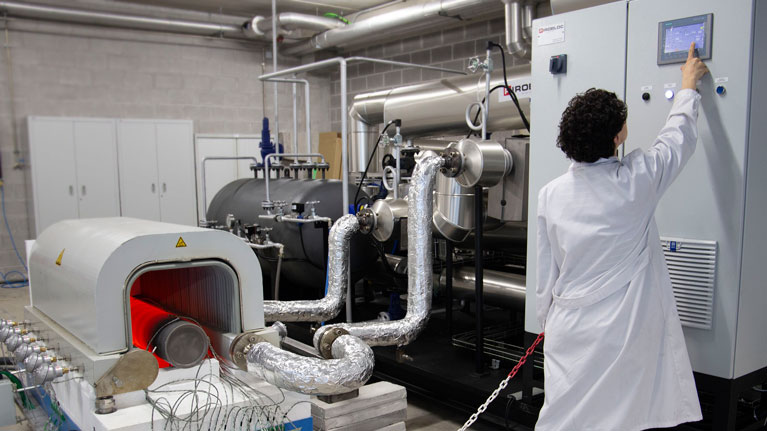Waste heat produced by industrial components used as a new energy source
Tekniker technology centre is participating in BEROA-GO, an innovative energy efficiency project that will allow waste heat produced by incandescent parts to be used in a broad range of industrial processes.

Compared to other countries and regions, the industrial sector plays a highly outstanding role in the Basque economy. Large amounts of energy are consumed in this sector that has become a key target to achieve energy efficiency goals set at a European. As described in the Basque Country’s Energy 2030 Strategy, one of its key actions is focused on improving the Basque industry’s competitiveness and sustainability in terms of energy efficiency.
The strategy stresses how crucial it is to recover waste heat produced during industrial processes as it is not yet happening. Specifically, there is a heat source that is not being used in the form of energy produced by solid incandescent elements whose heat is lost in the environment during cooling processes. This approach was supported in the 90s’ by a joint study carried out by the University of the Basque Country and the Public University of Navarre1 that analysed surplus heat generated by Basque industrial firms. As a result of the high temperatures reached by incandescent solids, radiation becomes the predominant mechanism for heat transmission when designing a capturing system for waste heat.
BEROA-GO, a pioneer project in terms of energy recovery
Although a number of projects have been carried to make the most of waste heat produced by fluids and gases, solid parts have not yet been addressed due to the technical difficulties arising from collecting and transporting energy that is to be recovered. To address this challenge, the BEROA-GO project has focused on developing a system that can capture heat produced by incandescent parts for new uses.
This has allowed the Tekniker and Tecnalia research team to create a prototype for a heat capturing system for which a joint patent application has been filed. A test bench has also been set up at Tekniker’s facilities to test prototypes reaching up to 850ºC flow temperatures to simulate incandescent parts and capture heat to be used in other industrial processes (improving their global efficiency), to produce electricity or provide climatisation. Some studies have also addressed the potential use of this technology in the steel and glass sectors.
More specifically, Tekniker, has provided its expertise to design thermal systems and equipment, especially for high temperature operations in which the most relevant mechanism is related to the transmission of heat via radiation.
In terms of design, the knowledge developed by the technology centre on the behaviour and characteristics of heat-carrying fluids has been crucial to properly cope with highly demanding operating conditions. The technology centre’s experience with regard to developing customised testing equipment for different applications has also made it possible to address the development of a test bench on which the prototype can be tested under a diverse range of conditions.
In addition to its major potential in terms of improving process energy efficiency, the system will reduce the problems caused by irradiated heat for anybody working in these industrial environments and will be less damaging for nearby machines.
Tecnalia, on the other hand, has provided support to develop a high-absorption paint for high temperatures that substantially improves heat capture via radiation and has a positive influence on system performance. The organisation has also focused on designing and developing a prototype for a heat capturing device to materialise all the collaborative work carried out within the scope of this project.
The BEROA-GO initiative is an outstanding example of what research can offer with regard to developing new solutions that can improve energy efficiency in the Basque industrial sector, especially as regards waste heat recovery. Both the thermal energy present in solids and the products emerging from high temperature processes play an outstanding role as regards preventing the underutilisation of industrial heat. Consequently, we are facing a major opportunity as regards developing more sustainable and efficient industrial processes. BEROA-GO is a highly innovative project and there are currently no other commercial solutions available capture radiated waste heat.
BEROA-GO was born in the form of a project led by Tecnalia and funded by the Basque Government under the Elkartek call. Mention must also be made of the collaborative support provided by Mondragon Unibertsitatea (theoretical support via simulations) and Sidenor I+D (a benchmark in the industrial sector). It was a later stage when Tekniker and Tecnalia decided to boost the project even further by providing all the necessary required. In order to achieve this goal, both organisations signed a strategic collaboration agreement to jointly develop future solutions within the framework of industrial heat recovery.
[1] TECHNOLOGICAL RECOVERY POTENTIAL OF WASTE HEAT IN THE INDUSTRY OF THE BASQUE COUNTRY. J. J. Bonilla,** J. M. Blanco,* L. López and J. M. Salas. *Departamento de Ingeniería Mecánica, Universidad Pública de Navarra, 3 1006, Pamplona, Spain. Departamentode Máquinas y Motores Térmicos, Universidad del País Vasco, 48012, Bilbao, Spain (Received 24 April 1996).
